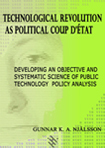|
|  |
Government Policy Textbook Warns Nordic Countries Heading Toward Innovation Policy Crisis
SPNW NewsWire - 20.01.2010 23:24
National Stagnation, Cultural Insularism and a Limited Culture of Public Participation Could be Driving Forces behind an Approaching Innovation Crisis, New Textbook Warns.

Technological Revoluition as Political Coup D'etat ISBN13 9789529950843
(SPNW NewsWire International) Bean counters at the national and local level may just be set to receive one tool they have been dreaming of since the technology hype of the 1990's threw them off guard. A new textbook manages to cut through all of the tech-hype and philosophical ramblings of various neo-constructivist authors and to provide a down-to-earth account of how governments in fact deal with the e-government and information technology issue. And that includes how they are often lobbied by large technology operations eager to sell their ideas and their solutions.
The textbook Techological Revolution as Political Coup D'etat: Developing an Objective and Systematic Science of Public Technology Policy Analysis seeks to do exactly as its title indicates- to give researchers and government administrators a way of even attempting to judge the value of e-government and other new information technology projects that they are being asked to pump taxpayer money into. It may also provide them with more ways to judge who is in fact dictating where the money goes and how it is spent.
Finland, Sweden and Canada are taken as case studies by the author Gunnar K. A. Njalsson, an expert in national innovation and technology policy who also specializes in the subject of International Space Law. Fluent in various languages including Finnish, Swedish, English, Norwegian, Danish and Spanish textbook author Njalsson has gained access to documents and international scholarship hidden from most academics by the language barrier. Njalsson who is an active member of the IEEE also has a multidisciplinary background in Technology, Economics and Public Administration which seems to influence the text and vantage point rendering the book much more systematic, critical and lucid than is the case with many other textbooks covering the subject matter.
The textbook, which is officially due out in February 2010 after several delays for last-minute updates and revisions, is logically structured to present a complete model for technology policy analysis. A model referred to by the author as the Integrated Model for Public Technology Policy Analysis is gradually assembled chapter by chapter in the book.
Each chapter deals thoroughly with a particular segment of the model and ties it to empirical data and previous research carried out by the author himself and by other policy analysts. In the final chapters specific methodologies are suggested as appropriate to be used in association with the previously covered segments of the Integrated Model. Empirical examples from Finland, Canada and Sweden are briefly examined using the model and methodologies.
“This textbook is the culmination of numerous scientific articles, empirical studies, interviews and a critical examination of the jungle of theories and abstract models which came before” says Njalsson. “Policy analysts, government, managers as well as university and college instructors may have an easier time dealing with the subject manner now that this book has at least in part systematized all of this information and tried to present it critically and cogently for decision-makers” he adds.
The textbook focuses on technology policy in countries such as Canada, Finland and Sweden in part because they are OECD countries and considered to be leaders in e-government. However, the author points out disparities between Canada and the other two countries, including the seeming paradox of Canada's low R&D investment and first place position as an effective e-government country. The textbook isolates one of the success drivers as being the local administrative culture with good coordination amongst different agencies and the country's technology policy process which is more open for influence by all stakeholders.
This in turn may explain why less investment per capita has not affected Canada's status as the number one country for e-government in comparison with Finland and Sweden- Nordic countries which are increasingly slipping behind due to national stagnation as well as poor communication, cultural insularism and resistance to wide participation or new impulses in their systems of public administration.
“E-government or various information technology projects are not an end in and of themselves; they are considered in most cases to be a tool for doing what the government already does, but more efficiently and closer to stakeholders” Njalsson points out. “If an organization is dysfunctional and agencies cannot manage to work together and communicate effectively, then national information technology projects are ultimately nothing more than a sophisticated way of pouring taxpayer money into a black hole” Njalsson warns. He points to previous information technology projects such as the electronic identity card in Finland and the IT Fornebu project in Norway as examples of how the poor culture of communication between agencies and with stakeholders has rendered potentially beneficial public technology projects almost worthless and very costly for taxpayers.
The textbook Techological Revolution as Political Coup D'etat: Developing an Objective and Systematic Science of Public Technology Policy Analysis can be pre-ordered from Ingram Books by universities, libraries, wholesalers and government agencies. Detailed information about this upcoming textbook title is available from Library and Archives Canada.
(With files from USA Today and Telam-Argentina)
USA Today Wire Notice:
 http://content.usatoday.com/topics/article/Places,+Geography/Countries/Canada/09op7Xq4xm5bT/1 http://content.usatoday.com/topics/article/Places,+Geography/Countries/Canada/09op7Xq4xm5bT/1
 Website: http://www.spacepol.com.ar Website: http://www.spacepol.com.ar
|
| Read more about: europa gentechnologie kunst, cultuur en muziek media | | supplements | |


